Discover 15 hidden attractions, cool sights, and unusual things to do in Prince Edward Island (Canada). Don't miss out on these must-see attractions: Blockhouse Point Light, Point Prim Lighthouse, and Wood Islands Lighthouse. Also, be sure to include North Rustico Harbour Light in your itinerary.
Below, you can find the list of the most amazing places you should visit in Prince Edward Island (Prince Edward Island).
Table of Contents
Blockhouse Point Light

The Blockhouse Point Light is a lighthouse at Rocky Point, Prince Edward Island, Canada, on the western shore of Charlottetown Harbour. The present lighthouse, constructed in 1876, replaced older lighthouses at the site which are believed to have been constructed as early as 1846 to serve as a light for the harbour. The lighthouse is active as of 2019, and consists of an 18.3 m wooden pyramidal tower, attached to a two-storey keeper's house.[1]
Point Prim Lighthouse
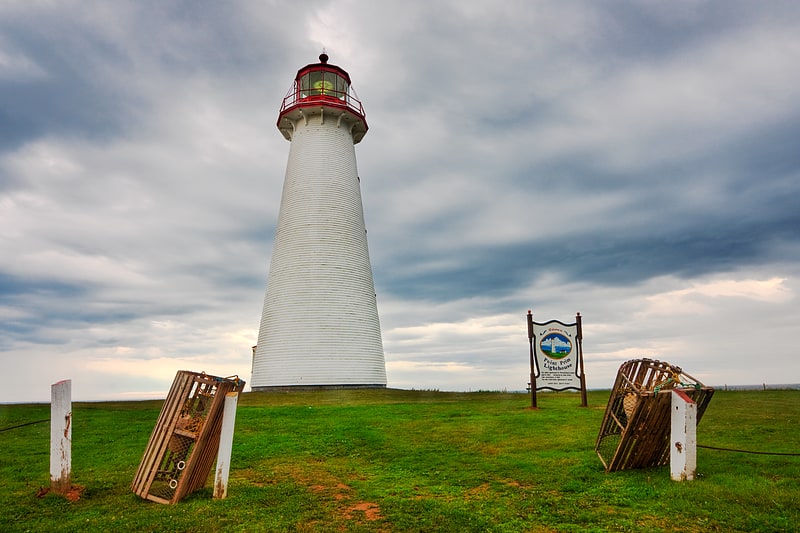
Historical landmark in Belfast, Prince Edward Island. The Point Prim Lighthouse is a lighthouse on Prince Edward Island, Canada. It is located at the end of Point Prim Road, also known as Route 209.
The lighthouse itself is 18.5 metres (60.7 feet) tall when measured from its foundation to the weathervane. It is made of brick and is circular—one of only two so constructed this way in Canada. The other is called Fisgard Lighthouse and is located in British Columbia.
There is a keeper's cottage situated to the southeast of the tower. It measures 19.5 metres (34 feet) by 4 metres (14 feet). Due to the small size of the cottage, the keeper normally lived in it alone. In the summer, however, his family would often come and stay with him.[2]
Address: 2147 Prim Rd Pt, Prince Edward Island
Wood Islands Lighthouse

Lighthouse in Belle River, Prince Edward Island. The Wood Islands Lighthouse is a historic lighthouse built by Joseph Tomlinson III situated on the southeastern shore of Prince Edward Island, located in the community of Wood Islands. The lighthouse is a well-preserved three storey tower with an adjoining 1+1⁄2-storey keeper's residence. The white shingled tower is topped by a red iron lantern, which is enclosed by a white railing on the observation deck. The red roof of the dwelling provides a striking contrast to the white shingled exterior of the dwelling.
It was one of the last three lights on Prince Edward Island to be fully automated, and the last where the keeper and his family lived. The lighthouse and residence are now open as a museum, with exhibits about the history of lighthouses, ferry service and fishing on the island, and includes a 1950s period kitchen and keeper's quarters.[3]
North Rustico Harbour Light
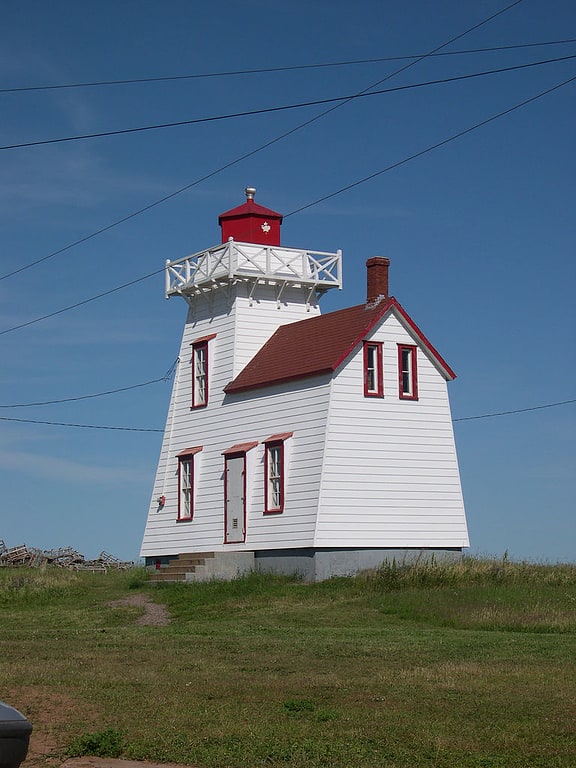
Lighthouse in New Glasgow, Prince Edward Island. The North Rustico Harbour Light is an active lighthouse on the central north coast of Prince Edward Island, Canada. The station was established in 1876 and the lighthouse itself was built in 1899. It is still active, and has a focal plane of 12.5 m; and a yellow light, 5 seconds on, 5 seconds off. The tower itself is 10 m high with a square pyramidal wood tower with lantern and gallery.[4]
Address: 318 Harbourview Dr, C0A 1X0 North Rustico
Farmers' Bank of Rustico
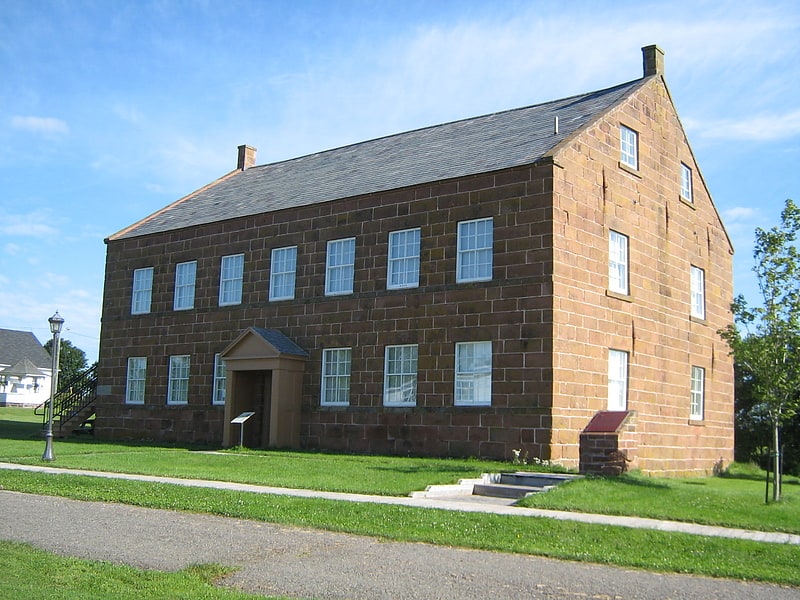
The Farmers' Bank of Rustico operated in the village of South Rustico, Prince Edward Island, from 1864 to 1894. It is often considered to have been the first community-based bank in Canada. Founded and managed under the leadership of Father Georges-Antoine Belcourt, the Farmer's Bank of Rustico was established on April 21, 1863. The bank received Royal Assent for its act of incorporation at the Court of Windsor on April 7, 1864." The first president was farmer Jerome Doiron, and the first cashier was Marinus Blanchard, a local school teacher.
The Farmers' Bank "was the precursor of the North American credit union movement through its influence upon the pioneer credit union organizer, Alphonse Desjardins of Quebec." Like the later credit unions, the Farmers' Bank accepted deposits and provided loans, primarily for less than 1 year. It showed that villagers could successfully operate a financial institution without the assistance of banking experts. However, there are also important differences. The Bank issued its own currency and kept its working funds in specie. But it never built up a substantial reserve fund—preferring to return most of its annual profits to shareholders as dividends.
The Farmers' Bank was also one of the earliest manifestations of a strong movement of Acadian economic self-determination. Belcourt's innovative ideas also gave rise to dozens of seed grain banks in Acadian communities in the 1860s, including one in Egmont Bay that was a precursor to the later co-operative movement in the Evangeline region of the Island. The Bank also anticipated Mouvement des caisses populaires acadiennes, a 200,000 member network of credit unions in New Brunswick.
As such, it played an important role in the development of the Acadian community in the Maritimes. In the view of MacDonald, "the steady availability of cheap credit for thirty years enabled the predominantly Acadian community to attain economic independence." However, the Canadian Bank Act of 1871 did not envision such small financial institutions, and the Farmers' Bank wound up its operations when its charter was not renewed in 1894.[5]
Address: 2188 Church Road, Prince Edward Island
Port-la-Joye–Fort Amherst
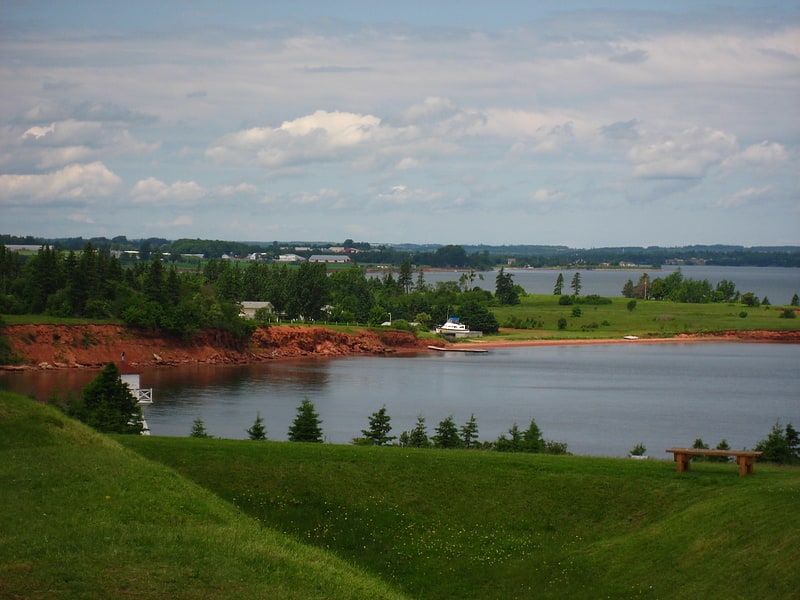
Historical landmark in Rocky Point, Prince Edward Island. Skmaqn–Port-la-Joye–Fort Amherst is a National Historic Site located in Rocky Point, Prince Edward Island.
This location has the double distinction of hosting one of the first Acadian settlements in present-day Prince Edward Island, as well as the first military fortification on the island while under control of France as well as the first military fortification on the island while under control of Britain.
From 1720 to 1770 Port-la-Joye, later named Fort Amherst, served as the seat of government and port of entry for settlers to the island while under both French and British control. As such, it played an important role as a colonial outpost in the French-British struggle for dominance in North America.
The site was designated a National Historic Site by Alvin Hamilton, the Minister of Northern Affairs and National Resources, on May 27, 1958, on the advice of the national Historic Sites and Monuments Board. The property was acquired by the federal government in 1959, and the present visitor center opened in 1973. The site's name was changed from Port-la-Joye—Fort Amherst NHS to Skmaqn—Port-la-Joye—Fort Amherst NHS on February 16, 2018. The additional Mi’kmaq word means “the waiting place”, and is thought to originate between 1725 and 1758, "when Mi’kmaq and French leaders met annually at the site to renew their relationship and military alliance."[6]
Address: 191 Hache Gallant Dr, C0A 1H2 Rocky Point (Afton)
Cabot Beach Provincial Park
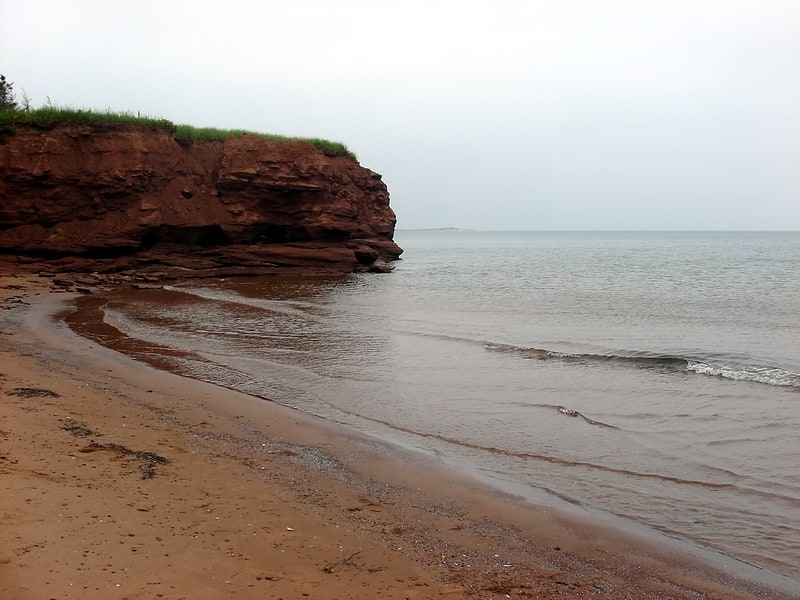
Park in Prince Edward Island, Canada. Cabot Beach Provincial Park is a provincial park in Prince Edward Island, Canada. It is located in Malpeque Bay.
Cabot Beach is the largest park in western PEI. This beautiful park has a large day-use area with playground equipment, an activity centre with children's programs and a naturalist on staff who provides guided nature walks. There is also supervised swimming on scenic Malpeque Bay.
Cabot Beach was host to the 4th (1977) and the 10th (2001) Canadian Scout Jamboree.[7]
St. Simon & St. Jude Church
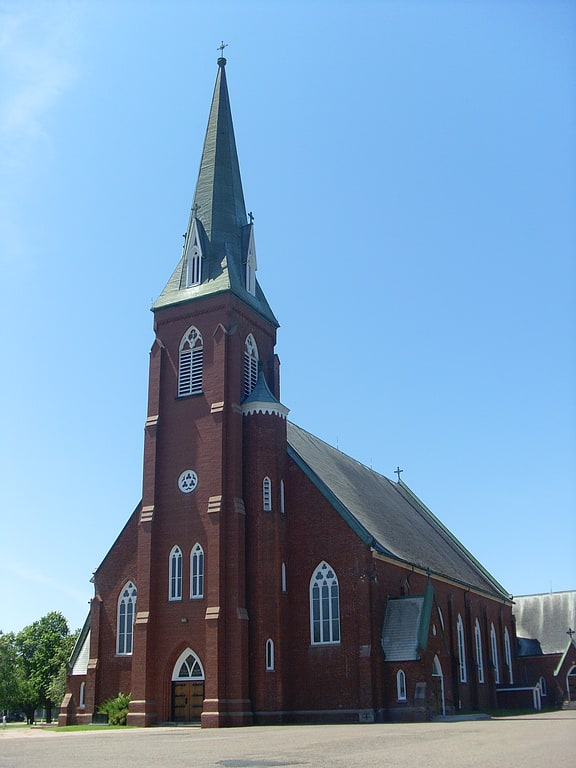
St. Simon & St. Jude Church, known colloquially as Tignish Church is a 19th-century Roman Catholic church located in Tignish parish, Prince Edward Island, Canada. As of 2006, it is the single largest church on Prince Edward Island, measuring 185 feet high. It can be clearly seen for 6 miles on flat land, and for many more miles at sea. It is perhaps most famous for its widely publicized apparition of Jesus event.
The church, along with the local post office, is one of the few original structures in Tignish remaining in excellent condition. Surrounding churches include Immaculate Conception Church located 6 miles SW of Tignish in Palmer Road, as well as Greenmount United Church located 5 miles S of Tignish. Many from outside the official parish, such as those in Palmer Road or Alberton parishes, will attend the church.[8]
Address: 313 Church St, C0B 2B0 Tignish
Brookvale Provincial Park

Ski area in North Wiltshire, Prince Edward Island. Mark Arendz Provincial Ski Park is a provincial park in Prince Edward Island, Canada.
It is located in the community of Brookvale and functions as a winter activity park with the following attractions:
- alpine ski hill (the only facility in the province)
- nordic ski and snowshoeing trails
- mountain biking trails (spring, summer, fall)
Address: 2018 Route 13, Prince Edward Island
Jacques Cartier Provincial Park

Park in Prince Edward Island, Canada. Jacques Cartier Provincial Park is a provincial park in northwestern Prince Edward Island, Canada, approximately 6 km northeast of Alberton. The park is named for Jacques Cartier, who in 1534 was the first European to arrive on the island. This is celebrated each year in July on Rediscovery Day.[10]
Address: 16448 Rte 12, Prince Edward Island
Seacow Head Light
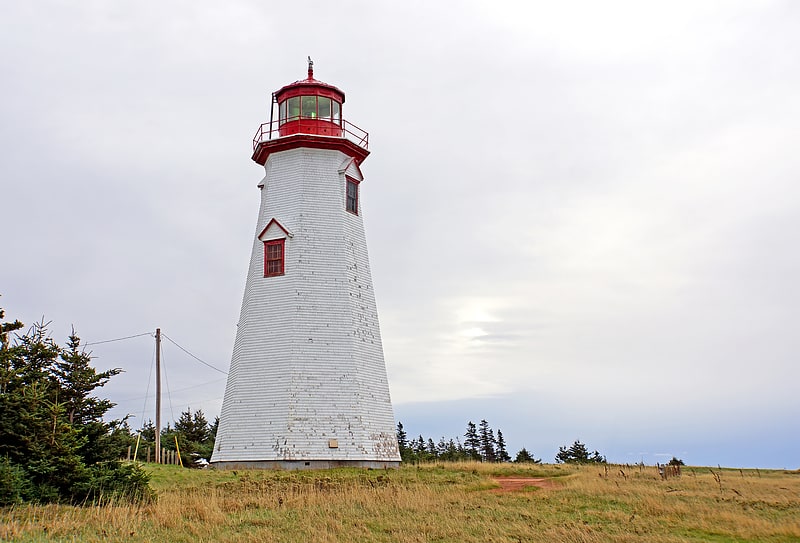
Lighthouse in Prince Edward Island, Canada. The Seacow Head Light is a lighthouse on the south-central coast of Prince Edward Island, Canada, west of Central Bedeque. It was built in 1864. The lighthouse was relocated in 1979 to avoid erosion. The lighthouse appeared in several episodes of the television series Road to Avonlea and was home to one of the series' main characters, Gus Pike.
The name "Seacow Head" was given in reference to the walrus, formerly abundant in nearby waters, and is not connected with Steller's Sea Cow or other Sirenia.[11]
Address: Lighthouse Road, C0B 1C0 Prince Edward Island
Cape Tryon Light

Lighthouse in French River, Prince Edward Island. The Cape Tryon Light is a lighthouse on the western north coast of Prince Edward Island, Canada, located on Cousins Shore about 4 km west of the cape. The station was built in 1905 and it characterised as a white building with red trim; with the lantern painted red.
The original Cape Tryon lighthouse was deactivated in 1969. A second lighthouse was built on Cape Tryon itself, opened in 1969, and is still active. It is located a few kilometres north of the village of French River.[12]
Panmure Island Provincial Park
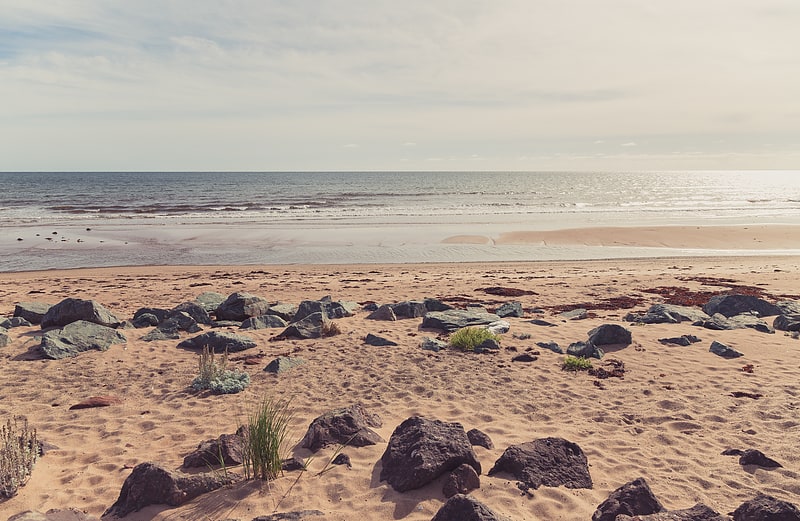
Park in Prince Edward Island, Canada. Panmure Island Provincial Park is a provincial park in Prince Edward Island, Canada. It is located along a causeway connecting Prince Edward Island with Panmure Island. The Native Council of Prince Edward Island hosts their annual Abegweit Pow Wow in the park.[13]
Address: 350 Panmure Island Road, Route 347, C0A 1L0 Prince Edward Island
North Cape Light

Lighthouse in Prince Edward Island. The North Cape Light is an active lighthouse on Prince Edward Island, Canada. It was built in 1867, and is still active.[14]
Warren Cove Range Lights
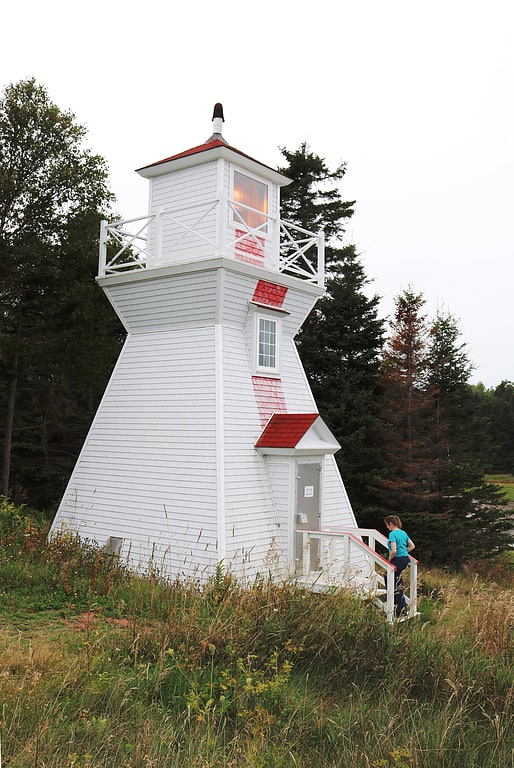
The Warren Cove Range Lights are a set of range lights on Rocky Point, Prince Edward Island, Canada. They were built in 1907, and are still active.[15]